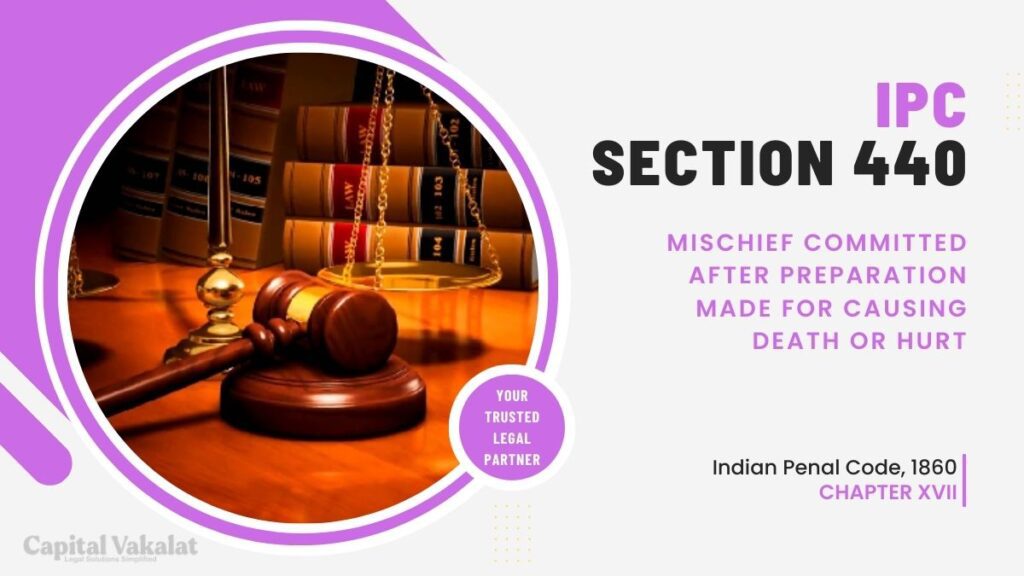Understanding the legal intricacies of Section 440 IPC is crucial in comprehending the severity of mischief committed after preparation made for causing death or hurt. This section delves into the intentional actions that go beyond mere mischief, exploring the legal implications and consequences associated with such acts.

In the realm of criminal law, Section 440 IPC holds a distinctive place, addressing mischief that extends beyond the ordinary and involves a premeditated intent to cause death or hurt. This article aims to unravel the complexities of Section 440 IPC, shedding light on its key elements, legal consequences, and the challenges in its prosecution.
Understanding Section 440 IPC
Definition and Scope of Mischief
Mischief, in a legal context, encompasses a wide array of intentional, wrongful acts that cause damage to property, life, or well-being. Section 440 IPC takes mischief to another level by focusing on situations where the intent goes beyond causing general harm.
Specifics of Section 440 IPC
Section 440 IPC explicitly deals with situations where an individual not only commits mischief but also takes preparatory steps to cause death or hurt. This provision is crucial in differentiating between simple mischief and more severe offenses involving premeditated harm.
Preparation for Causing Death or Hurt
Explanation of Intent Behind the Preparation
The preparation mentioned in Section 440 IPC involves a deliberate and conscious effort to cause significant harm. Understanding the motive behind such preparation is pivotal in establishing the guilt of the accused.
Legal Consequences of Preparation
The law recognizes the gravity of preparing to cause death or hurt. Individuals found guilty under Section 440 IPC face severe legal consequences, reflecting the societal abhorrence for actions that go beyond spontaneous mischief.
Key Elements of Section 440 IPC
Intent to Cause Death or Hurt
One of the critical elements of Section 440 IPC is establishing the intent to cause death or hurt. The prosecution must demonstrate that the accused had a specific and conscious desire to inflict serious harm.
Unlawful Preparation
The preparation mentioned in the section must be unlawful. Legitimate actions, even if resulting in harm, do not fall under the purview of Section 440 IPC. Unlawful preparation involves activities outside the bounds of legal and ethical norms.
Nexus Between Preparation and Mischief
A crucial aspect in proving guilt under Section 440 IPC is establishing a direct connection between the preparatory actions and the subsequent mischief. This nexus is vital for a robust legal case.
Legal Consequences
Penalties under Section 440 IPC
Individuals convicted under Section 440 IPC can face severe penalties, including imprisonment. The legal system recognizes the need to deter and punish acts that involve calculated harm.
Relevant Case Studies
Examining past cases where Section 440 IPC was invoked provides valuable insights into the application of the law and the varying circumstances that led to its use.
Interplay with Other Legal Sections
Relationship with Other Sections of the IPC
Understanding how Section 440 IPC interacts with other sections of the Indian Penal Code is crucial for a comprehensive comprehension of the legal landscape.
Distinctions and Overlaps
Certain legal nuances may lead to overlaps or distinctions between Section 440 IPC and other provisions. Clarifying these distinctions is vital for legal practitioners and the public alike.
Challenges in Prosecution
Difficulties in Proving Intent
Establishing the intent to cause death or hurt can be challenging. Legal professionals often face difficulties in presenting concrete evidence of a defendant’s state of mind.
Gathering Evidence of Unlawful Preparation
Proving that the preparation was indeed unlawful requires a meticulous collection of evidence. This includes documentation, witness testimonies, and expert opinions.
Landmark Cases
Notable Cases Highlighting the Application of Section 440 IPC
Examining landmark cases provides valuable insights into the interpretation and application of Section 440 IPC in diverse situations.
Impact on Legal Precedents
Decisions made in significant cases under Section 440 IPC contribute to shaping legal precedents, influencing future rulings and interpretations.
Public Awareness and Safety Measures
Importance of Understanding Legal Implications
Public awareness regarding Section 440 IPC is crucial for fostering a sense of responsibility and deterring potential offenders. Education on legal consequences can contribute to a safer society.
Measures to Prevent Malicious Intent
Preventing acts falling under Section 440 IPC involves a combination of legal enforcement and societal initiatives. Creating an environment that discourages malicious intent is paramount.
Conclusion
In conclusion, Section 440 IPC serves as a legal deterrent against acts of mischief that extend into the realm of premeditated harm. Understanding its nuances is essential for legal practitioners, law enforcement, and the general public. The law reflects society’s commitment to protecting individuals from intentional and calculated harm.
Frequently Asked Questions
What penalties can be imposed under Section 440 IPC?
Individuals convicted under Section 440 IPC can face severe penalties, including imprisonment.
How can one prove intent under Section 440 IPC?
Proving intent involves presenting evidence of a deliberate and conscious desire to cause death or hurt, which can be challenging.
Are there any preventive measures outlined in the law to curb Section 440 IPC offenses?
While the law itself does not prescribe specific preventive measures, public awareness and education are vital in discouraging potential offenders.
Can Section 440 IPC be applied in cases of unintentional harm caused during preparation?
No, the section specifically requires an intentional and conscious effort to cause harm, excluding cases of unintentional harm.